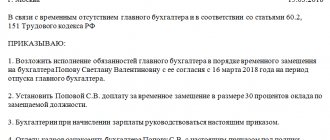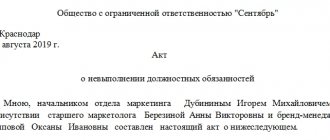In order to dismiss an employee, the director of the organization must order the issuance of an order. At the legislative level, a unified sample order for dismissal for absenteeism has not been developed. To compile it, the T8 form or a specially developed and used within one organization form can be used. The main requirement is full compliance with the standards developed for this type of documentation.
Truancy - what is it
The definition of this concept is given in clause 6, part 1 of Art. 81 Labor Code of the Russian Federation. In accordance with it, if the time of absence from the workplace is more than 4 hours in a row, this is absenteeism.
To issue a dismissal order on this basis, the following conditions must be met:
- the period of absence from service is not less than that established by the legislator (4 hours or a full working day);
- a contract has been concluded with the employee, which specifies the length of the working day and the place where official duties will be performed;
- the reason for absence is unjustified;
- the circumstances of the employee’s non-appearance were checked with documentary evidence.
The law does not specify the division of truancy into types, but in practice they can be divided into:
- short-term - when the employee is away for a short period of time, while maintaining the possibility of maintaining contact with him;
- repeated - when 2 or more cases of absence are recorded during a calendar year, while the employee who committed absenteeism cannot give valid reasons for this;
- long - absence from place for a long period of time (several days/weeks/months in a row), while the director has no way to contact him.
Depending on the reasons, duration and regularity of absences from work, a decision is made to terminate the employment relationship with the employee who committed absenteeism.
What is considered truancy (regulatory framework)?
When an employee has been absent for several hours in a row, and his disgruntled employer does not intend to let this situation take its course, it is better for the company’s personnel service to refresh its memory of the provisions of the two main rules on the use of disciplinary measures. Direct instructions on how to clear the ranks of the team of truants are in the following standards:
- subparagraph a) of paragraph 6) of Article 81 of the Labor Code;
- clause 39 of the Resolution of the Plenum of the Supreme Council No. 2 of 2004.
The listed standards contain a number of criteria that help to clearly qualify the time of being late or not showing up as absenteeism. It is legal to recognize an offense as a gross violation of discipline if all of the following signs coincide at once:
- the person was not seen throughout the entire shift or for 4 or more hours (not counting the lunch break);
- the time period was continuous (summing up periods is unacceptable);
- the employee is not at the work point specified in his contract (in accordance with the requirements of Article 209 of the Labor Code);
- the reason for failure to appear or absence for many hours has not been agreed upon with the employer and is not recognized by him as valid.
A specialist hired on a part-time basis (4 hours or less per shift) may also suffer if he decides to miss at least one exit. Article 81 of the Labor Code specifically states that the duration of the shift does not play a role if a person has never checked in at his work point.
If, upon examination of the situation, it turns out that the employee’s absence does not meet all the criteria, then the offending specialist can only be punished for being late. In the case where this is the first violation, the maximum penalty in severity should not exceed the force of a reprimand, Art. 192 TK.
How to calculate the duration of absenteeism?
You can record the time of no-show or lateness from the first minute of the start of the working day or unauthorized unmotivated absence from the workplace. The immediate superior of the violator of discipline or his colleagues (both in writing and orally) can notify management.
To correctly classify absenteeism or tardiness, it is necessary to follow several rules for documenting and timing the situation:
- upon receipt of a signal from team members, officially confirm the fact of untimely arrival or unauthorized abandonment of work (report of one or more colleagues, recording from CCTV cameras, absence of a mark in the daily registration log of the time of appearance at the enterprise);
- in the same way it is necessary to record the hour and minute of the offender’s return;
- between two time marks a minimum of 4 hours and 1 minute must pass (minus a 60-minute meal break, which cannot be included in the total period);
- if a person never shows up (within the hours specified in his employment contract), then at the end of the day, witnesses to the misconduct must draw up and sign an absence report for the entire shift.
There are several conditions when missing work cannot be considered absenteeism, even if the reason for this action was not valid:
- if the employee appeared at the enterprise at least for a minute before lunch and after, and at the same time he has witnesses ready to confirm this;
- if the contract does not specify a specific place of work (workshop, machine number or office), but a general address, then the employee’s aimless movement around the outskirts of the enterprise territory cannot be considered absenteeism;
- if a part-time worker or a specialist invited for a part-time job has only the duration of the shift in the employment contract, but there is no fixed time frame, then he is free to come at any hour convenient for him (absenteeism can only be proven in the case where the employee never showed up superiors).
For example , a hired specialist left the office at 10:00 am without permission from his superiors and returned only at 2:30 pm. In a normal 8-hour working day, this absence cannot be considered absenteeism, even though the total period of absence was 4.5 hours. In this case, the main condition is not met: the time period is interrupted by a lunch break, which means it lasts 3.5 hours.
It is extremely important to clearly record the start time of absence from work and the moment the employee reports or ends the shift. If in court the employee can prove bias or distortion of these facts, which will shorten the period of unauthorized absence, then the decision will be made in favor of the hired person.
Valid reasons for absenteeism
An explanatory statement from the guilty party will help to assess what happened. Providing an opportunity to clarify the situation is the direct responsibility of the employer. If this requirement is not met, then the dismissal may be considered illegal and the form of punishment of the employee excessive.
After appearing at work, the employer must give the absentee 2 working days to provide evidence of valid reasons for absence (minus weekends, holidays, vacation or sick leave). Refusal to provide explanations or failure to provide them within 2 days releases management from the obligation to take into account the employee’s opinion.
If written excuses are nevertheless received, then the employer needs to know that the root causes of absenteeism can be unconditionally valid (as required by the Labor Code of the Russian Federation) or subjective (according to management or inspection bodies). The following are guaranteed to justify:
- failure to appear agreed with the employer (vacation, time off, business trip, separate assignment);
- sick leave (you can provide a certificate of incapacity for work any day 6 months after discharge);
- using days of rest or release from work, even without the consent of the employer, if the latter was obliged to provide them (pregnant leave, recovery days for the donor, medical examination, study leave);
- participation in court hearings, investigative activities and pre-trial proceedings;
- a strike organized in accordance with the law and refusal to work due to malicious non-payment of wages, Art. 145 TK.
The main condition is the availability of supporting documents. However, prior notice to the employer does not always play a decisive role. For example, a sick leave certificate or a summons can be provided in person.
Subjectively assessed circumstances usually include unforeseen life situations, domestic accidents, illness of loved ones, visiting a clinic without opening a certificate of incapacity for work, etc. The right to evaluate and recognize the cause as an objectively compelling circumstance remains with management.
Reasons for no-show
It is not always possible for an employee to be relieved of duty by signing an order in case of absence from duty. To terminate a contract, the boss must prove that the employee’s absence has no valid reason.
The legislator does not establish which circumstances are considered valid, but according to the general principle, a number of life circumstances are considered such.
So, dismissal of an employee who has committed absenteeism is impossible if he did not show up for work for one of the following reasons:
- Unsatisfactory health condition requiring seeking medical help. As well as accompanying the patient and/or providing him with first aid or opening a certificate of incapacity for work (both based on the health problems of the employee himself and the illness of his minor child).
- Contacting a medical institution for examination, examination or vaccination.
- Involvement in investigative activities, participation in trials, performance of government tasks.
- Taking part in a strike/meeting or failing to show up for work due to non-receipt of wages.
- Emergency incidents (traffic accident, flight or other transport delay, problems with utility systems).
- Natural disasters (floods, landslides, avalanches, etc.).
This is also important to know:
Dismissal during voluntary leave
To ensure that absenteeism in the listed cases does not become grounds for dismissal, it is necessary to provide evidence of a valid reason:
- in case of a visit to medical institutions or law enforcement agencies, you must bring a certificate confirming your visit to the appropriate institution.
- In case of an accident, you can also request a supporting certificate from the inspectors of the State Traffic Inspectorate who draw up the report.
- A flight delay can be proven by presenting an amended schedule or a ticket (passport) with an arrival stamp.
- The director can learn about participation in rallies or the occurrence of global force majeure circumstances (for example, natural disasters) from the media.
Termination of the contract in any of the listed cases upon presentation of supporting documents will be considered illegal, which will entail consequences for management.
Good and bad reasons
Not every absence of an employee is considered absenteeism. It happens that a citizen is forced not to show up or leave his place of work due to emergency circumstances. Such reasons are recognized as valid and allow absence from work to be considered absenteeism.
Circumstances of this nature include:
- deterioration of one’s own health, causing the need to seek medical help;
- illness or injury of other people requiring care or support;
- visiting a medical institution for the purpose of examination, examination, vaccination;
- participation in events of national importance: investigative actions, court hearings, performing special tasks;
- open refusal to show up for work due to non-payment of wages, strike, rally, other open forms of protest;
- various types of emergencies: accidents, incidents, transport collapse;
- circumstances of force majeure – various natural disasters.
Any valid reason requires informing the company administration. If it is possible to contact the employer, the employee is obliged to do so, promptly notifying him of the incident.
Any of the unforeseen circumstances must be documented:
- participation in open expressions of protest is documented by a certificate from law enforcement agencies or medical institutions;
- the presence of force majeure circumstances is proven by publications and reports in the media.
Please note! Absence from work will not be considered absenteeism only if there are documents confirming the existence of a serious reason. Otherwise, the employer has the right to classify the employee as a violator of labor discipline by applying enforcement measures.
Features of dismissal for absenteeism
The basis for unilateral cancellation of an employment contract by an employer may be absenteeism (Article 81 of the Labor Code). But for legal dismissal, the following features must be taken into account:
- The employee must be absent from exactly the place designated as his official position in the contract.
- Absenteeism must be documented - it is documented in a report card, memo/act from the head of the department.
- A separate report must be issued for each day of absence.
- After the employee appears, you must request an explanatory note. Only if it is determined that the reason for absenteeism is unjustified, the contract can be terminated.
- If an employee does not appear for work for a long period of time and does not communicate, the manager must take independent measures to establish the reasons for his absence from work. An order to cancel a contract can be signed only after investigative measures have been completed and they have been declared ineffective.
note
Absenteeism is sufficient grounds for termination of employment only at the discretion of management. For failure to appear for work, another disciplinary measure may be applied if the boss takes into account the employee’s length of service, as well as his services to the company.
Limitation periods
The employer retains the right to unilaterally terminate the employment contract for 1 calendar month from the date of discovery of the fact of absence from service.
This period is calculated without taking into account being on vacation and also the duration of an open sick leave.
Let's decide on a time frame
The timing of absence from the workplace is important when deciding on dismissal for absenteeism. If a person has missed the entire working day, then you just need to record his absence from work with the appropriate act, report and mark on the working time sheet and feel free to move on to the second point - finding out the reason for the absence.
But in the case when an employee did show up at work that day, this issue needs to be approached more carefully. To properly qualify absenteeism, the employee must be absent from the workplace for more than four consecutive hours during working hours, and this must be supported by appropriate evidence, and sometimes even a few minutes can play a decisive role.
The thing is that the lunch break, which, according to the Labor Code, is not included in working hours, as a rule, divides the standard eight-hour working day into two parts lasting four hours. Accordingly, if an employee’s working day is set from 9 a.m. to 6 p.m. with a break from 1 p.m. to 2 p.m., and he shows up at work at 1 p.m., then his absence can no longer be classified as absenteeism.
Proof of truancy
A common mistake made by managers is to immediately issue an order for dismissal without properly investigating the circumstances. This can lead to punishment for illegal dismissal, if the dismissed person decides to contact the supervisory authorities - he will have to pay a fine or reinstate the absentee at work.
- The optimal solution in case of absence from work is to record the fact of absence and stop the accrual of wages. To do this, an o is immediately placed on the report card, meaning that the reasons for the absence are unknown.
- If the absentee then brings a documentary explanation for the absence, the mark changes in accordance with it (for example, to “B” - illness).
- If there are no certificates or other documents, the mark is corrected to “PR”, which means absenteeism.
But even in this case, it is too early to issue and sign an order to cancel the contract. The next step is to require an explanatory note, which will be used to assess whether missing a working day is justified.
This is also important to know:
How compensation is made for unused vacation upon dismissal
If the truant refuses to give written explanations, it is necessary to document the fact of their request. To do this you can:
- hand over the notice in person against signature (which is not always successful);
- send a notification by registered mail with a description of the attachment and a receipt.
Procedure for dismissal for absenteeism
Compliance with all established requirements will protect the employer from subsequent problems with challenging the termination of the employment contract. The design of each document has its own characteristics:
- A mark on the timesheet that tracks working hours and employees’ compliance with the requirements of the regulations. On the day of absence, there should be an o next to the truant's last name, which will later be replaced, depending on the reasons for the absence. The report card is one of the documents that will be reviewed in the event of a trial, so filling it out correctly is important. Attention, look at the completed sample report card with the required marks.
- Recording the fact of absence by a special act. It is of paramount importance and is issued immediately on the day the employee fails to show up for work. If an employee is absent for several days, a separate report is drawn up for each of them.
- Notifying the employee of the planned termination of the contract and requesting an explanation of the reasons for absence in writing. It is issued to the employee personally against signature or sent to him by registered mail to his registration address.
- Receiving an explanatory note from the truant. It is compiled in free form in compliance with the requirements of business correspondence. The deadline for drawing up and submitting an explanatory note is 2 working days. Its presence or the employee’s written refusal to provide it is mandatory as evidence of compliance with the requirements for the dismissal procedure for absenteeism.
- If the truant refuses to provide an explanation, an act of refusal is drawn up in the presence of 2 witnesses who sign.
- Memo to the manager from the head of the department (division). This step is optional for small companies, but for organizations with several departments and branches it is a necessity.
- Issuing an order of dismissal for absenteeism, a sample of which is given below. Its main feature is that it does not require the issuance of a separate order on disciplinary action; it is enough to indicate in the text the basis for termination of the employment relationship - Article 81 of the Labor Code. You must attach the required attachments: an act and an explanatory note. For large companies, an additional report from the head of the department is required.
- Registration of orders in the order book.
- Drawing up a pay slip and familiarizing the dismissed person with the order. The order must contain the signatures of both parties to the labor relationship. If an employee refuses to sign an autograph, a certificate of refusal is drawn up in the presence of 2 witnesses who certify it with their signatures.
- Filling out the personal file and work book of the person being dismissed upon termination of the contract for absenteeism, a sample of which can be seen below.
- Issuing a work book to the dismissed person and making all due payments.
Documents grounds for issuing a dismissal order
To issue a dismissal order, you must have the following documents:
- Absence report – is drawn up, as a rule, by the head of the department (unit) in the presence of witnesses; these persons will confirm the absence of the employee with their signatures on the report;
- A memo from the head of the department stating that one of the department employees did not show up for work without warning and was absent for a long time without explaining the reasons. Read also the article: → “Memo on employee absenteeism.”
- An explanatory note from the offender, which provides an explanation of the disciplinary offense committed;
- Other documents proving the validity of the reason given by the offender in his explanation (for example, a document from the traffic police about an accident or a certificate from a medical institution about hospitalization);
- If there are consequences of absenteeism, relevant documents confirming their existence are provided;
- The employee’s refusal to provide explanations for his behavior, if the employer’s demand to explain the violation, the employee refuses to comply.
This is also important to know:
Certificates upon dismissal of an employee in 2021: what certificates does the employee receive?
A list of all papers related to the case should be provided in the dismissal order. They must be preserved and, if necessary, used as evidence for imposing a penalty in the form of dismissal.
Certificate of absence - design features
The act is drawn up by the head or specialist of the personnel department. The legislator does not establish a fixed form of the document, but it must reflect the following information:
- details of the enterprise;
- document's name;
- date of registration;
- information about the author of the document, witnesses and absent employee;
- date of absence from duty (indicating the period of absence);
- reason for missing a working day (if relevant information is available);
- signatures of all persons mentioned in the document.
Sample truancy report
Sample certificate of absence.
Documents grounds for drawing up an order
The fact of absenteeism must be recorded in writing.
Supporting documents include:
- certificate of absence from work (at the workplace). Since 4 hours are enough to establish the fact of absenteeism, on the first day of absence from work, 2 reports are drawn up - one for half a day. Subsequent days of absence are documented by drawing up a document daily;
- time sheet (days of absence from work are marked as having an unknown reason for NV);
- memorandum - drawn up by the head of the unit and informs the manager about the fact of absenteeism;
- explanatory note - written by the employee himself and contains a statement of the reasons for what happened;
- act of refusal to give explanations - drawn up when the offender is unwilling to explain anything regarding the offense committed.
Watch the video. Dismissal for absenteeism:
Notification - drafting features
The notification also does not have a legally established form, but must contain mandatory information. Otherwise, the risk of problems arising when the dismissed person contacts supervisory authorities is quite high.
This is also important to know:
How to calculate average daily earnings
The notification must indicate:
- Company details;
- information about the truant (full name and position);
- grounds for registration (indication of the fact of absence from the workplace);
- date and signature of the director.
The notice must be in writing. Its registration in the local acts of the company is mandatory.
The document is drawn up in 2 copies; the one that remains with the employer must bear the employee’s note indicating receipt and familiarization, indicating the signature and date.
Sample notification
Sample of filling out the form in Word format.
How to place an order
The dismissal process ends with an order. The purpose of the document is to impose a penalty and end the employment relationship with the violator. Form - T - 8, an arbitrarily compiled version of the document has no legal force.
The order specifies:
- information about the boss;
- number and date of registration;
- details of the offender, position;
- grounds for cancellation of the contract (Article 81 of the Labor Code);
- list of attached papers.
At the end there is a signature and company seal. A record of notification of the truant and his signature are required.
Sample dismissal order.doc
Filling nuances:
- indicating the reason for the cancellation of the employment contract, enter the article number and text from the Labor Code;
- details include name, number and date of registration;
- the date of drawing up the order and the date of dismissal may not coincide;
- if the employee does not appear, the absence of his signature on the order is recorded with a special record. A copy is sent to the truant.
If an agreement with several employees is terminated, it is allowed to issue 1 order.
Errors when forming an order:
- drawing up two directives: on the imposition of a reprimand and the annulment of the agreement;
- execution of the document after the completion of the period allotted for punishment;
- lack of signatures.
Violations of the contract termination process will result in a fine being imposed on the company management.
Explanatory – features of compilation
The explanatory note does not have a set form and is filled out randomly by the employee in compliance with the requirements of business correspondence. After identifying the fact of absenteeism, this is the employee’s response to management’s request.
The explanatory note must include the following information:
- About company;
- about the offender;
- about the reasons for absence from work.
At the end there must be a date and signature of the violator. It is necessary to attach documents confirming the reasons for missing a working day.
The explanatory notice for absenteeism, sample 2021, can be viewed below:
Order - procedure for drawing up
The document that completes the procedure for terminating an employment relationship for absence from work is an order of dismissal for absenteeism, a sample of which for 2021 can be viewed below.
This order performs 2 functions:
- imposes a disciplinary sanction on the offender (in the form of dismissal);
- terminates the employment relationship.
It is compiled according to the T-8 form and has mandatory fields. Here is a sample of filling out an order with an explanation for each.
| Part of a document | Explanations for filling |
| Number | An individual number is assigned under which the document will be included in personnel production. May consist of numbers, letters and symbols, depending on internal rules and journal entries. |
| date | Must fall within the period during which the contract can be terminated for missing a working day:
The moment of detection is the day when the violator’s immediate supervisor received information about the disciplinary offense. |
| Terminate the agreement | Indicate the details of the contract (date of conclusion and number). |
| Fire | Enter the date of termination of the employment agreement. It is determined by the manager after collecting all the documentation necessary for the procedure. |
| Base | Indicate an excerpt from the Labor Code indicating the number and paragraph (subclause a, clause 6, article 81) |
| Document basis | Enter the details of all documents drawn up since the violation was recorded. |
| Signatures | The signature of the manager and the person being dismissed must be signed (in a separate field of the T-8 form, which can be downloaded below). If the employee refuses to sign, a corresponding entry is made at the bottom of the document. |
| Union opinion | Mandatory to indicate if this body exists in the organization. |
Thus, an order to cancel an employment contract due to an employee’s failure to appear for work cannot be drawn up arbitrarily. There is a legally established form of document that must be followed in order for the dismissal to be legal. An arbitrarily completed order in this case will not have legal force.
Sample order
A sample order is available
Based on the wording of termination of the employment contract specified in the order, entries are made in the personal file and work book. The latter is handed over to the person being dismissed, after which he receives all the due accruals.
Features of filling out the order form
Filling nuances:
- when indicating the grounds for cancellation of the contract, not only the number of the article of the Labor Code is given, but also the text from the code;
- details of the documents drawn up during the dismissal process, which must be indicated in the order form - this is the name, number and date of preparation;
- the dates of issuance of the order and the actual termination of the contract may not coincide if the violator did not show up for work after missing out or did not begin his duties;
- if an employee does not come to work, his signature may not be on the order form, about which a corresponding inscription is made on the document (Article 84.1 of the Labor Code). A copy of the order with this mark is sent to the offender at his place of registration by registered mail.
note
If, due to absence from duty, a contract is terminated with several employees, one order form can be drawn up in Form T-8a, in accordance with standard requirements.
Typical errors
When drawing up any document, in particular an order to terminate an employment contract, errors may be made that will make its execution difficult.
The most common mistakes when issuing a dismissal order:
- Drawing up 2 orders - on the imposition of a disciplinary sanction and termination of the contract for failure to appear for duty.
- Issuance of an order after the expiration of the period established for punishment for violation.
- Indication of the grounds for cancellation of the employment agreement and the basis documents in the inappropriate fields of the document.
- Absence of the violator’s signature on the order form.
Any of the listed violations of the procedure for terminating an employment contract may become the basis for the imposition of penalties on management and reinstatement of the dismissed person in the workplace.
How to properly fire an employee for absenteeism: step-by-step instructions
The employer's inconsistent behavior when dismissing someone for absenteeism may result in a labor dispute simply because there was not enough documentary evidence to confirm the clearly inconsistent absence.
To avoid problems, you need to follow a simple algorithm:
- Establish the fact of failure to appear or leave without permission during a regulated working day, and record the time.
- Over the next four hours, check to see if the employee shows up on site. At this time, it is possible, but not necessary, to try to contact the person who is late to rule out sick leave or an accident.
- When an employee arrives at work or at the end of a shift, draw up a report about what happened.
- Demand in writing from the employee an explanation or provision of documents. Further steps can be taken no earlier than after 2 working days, art. 193 TK.
- If the reason set out in the explanatory note cannot be considered valid, the employer has the right to decide on the severity of the penalty imposed (from reprimand to dismissal). You can exercise your right within the next 30 days after the violation is discovered. The expiration of the deadline will mean complete rehabilitation on the part of the employer.
- Sign the dismissal order.
- Make an entry in the work book and pay the settlement. In such a situation, severance pay is not provided, but the rest of the salary and compensation for vacation will have to be calculated and paid out, Art. 84.1 TK.
The same norm stipulates that upon termination of an employment relationship, the personnel service must issue a certified copy of the order, a certificate of income subject to insurance premiums during the previous 2 full years.
How to confirm the fact of absence from work?
Before drawing up a truancy report, you need to carry out work to collect evidence (reports, videos, journal entries, etc.). Analysis of these materials will help you make a choice between two possible options:
- Absenteeism is clearly allowed;
- in fact, the person was on the territory, but did not perform duties or was distracted too often.
If the collected data is not enough to consider the offense as truancy, the collected evidence will be useful in holding the negligent specialist accountable for failure to fulfill his duties.
The act must set out the circumstances of the discovery of the offense, the date of compilation and the exact time, the signatures of witnesses and the violator himself. If the employee never comes to work, then the act is drawn up and signed without him.
The legislator does not oblige management to draw up a report daily if absenteeism lasts for several days. It is quite acceptable to draw up one document for the entire period immediately after the specialist’s appearance. But in this case, there is a possibility that the employee will be able to confirm the validity of the reasons for absence for some days (for example, a certificate from the hospital). Then the employer faces problems if the situation goes to court.
If absenteeism lasts several days, it is better for management to draw up a separate report for each fact of absence.
Can a pregnant woman be fired for absenteeism?
The Labor Code strictly limits the severity of measures taken against women in position. In Art. 261 of the Labor Code states that it is impossible to dismiss a pregnant woman from an existing enterprise without her desire. Management has only two types of disciplinary punishments against such truants - a warning and a reprimand.
But even if the usual procedure for dismissing an employee for absenteeism does not apply to an expectant mother, this does not mean that you need to let the situation go “on the brakes.” A correctly drawn up act and carefully collected evidence of a woman’s absence from work will allow the employer to:
- not to reasonably pay for missed work time;
- adjust the distribution of the bonus fund and production rate indicators, if the company has a similar system of material incentives;
- maintain discipline in the enterprise.
Immunity from dismissal does not relieve a pregnant woman from her job responsibilities. Moreover, days unpaid for this reason will directly affect the final amount of maternity benefits, since days of absenteeism are not excluded from the calculation period.
The nuances of dismissal for absenteeism
Termination of an employment contract has its own characteristics, depending on the category of the employee and the time of his entry into service. Let's take a closer look at them.
Is it possible to issue an order without the presence of the violator?
The procedure for terminating an employment agreement requires the execution of a number of documents, and almost all of them must bear the signature of the violator. His prolonged absence from the workplace makes the dismissal process difficult, but does not make it impossible.
If the offender does not show up for duty, management has 2 options:
- Wait for him to come out, recording each day of absence on the report card. The problem with the implementation of the violator’s labor duties can be solved by hiring a temporary employee or assigning functions to one of the team members.
- Request an explanatory note by sending a registered letter to the violator’s place of registration with a list of the contents and a notification of delivery. In this case, the time required for delivery of correspondence will have to be added to the waiting period for a response.
Different categories of employees
The legislator determines the category of persons whose dismissal in case of failure to appear for service is impossible. These include:
- women expecting the birth of a child;
- women raising young children (under 14 years old) alone;
- a mother/father with many children whose youngest child is under 3 years old;
- mother/father or sole breadwinner of a disabled child under 18 years of age.
Termination of an employment contract based on a pass is carried out in the general manner for all other categories of employees, including:
- young specialists;
- part-time workers;
- civil servants;
- military.
In this case, the last category will suffer the most, since after dismissal for absenteeism, it will be impossible to enter military service.
Illegal dismissal
Termination of an employment contract will be unlawful if:
- time away = 4 hours or less;
- the absence was not continuous (the employee appeared in the organization and left again);
- the employee is located on the territory of the enterprise, but is not assigned a separate workplace;
- the employee went on vacation without notifying management, but according to the approved schedule;
- the contract cancellation procedure was carried out with violations;
- despite the lack of prior notice, the employee provided documentary evidence that the reason for absence was valid;
- the employee was absent on a day of rest received without the director (for example, when donating blood).
Types of penalties
In labor relations, liability for violation of the terms of the employment contract is applied in the form of disciplinary sanctions.
The law provides for the following types:
- comment;
- reprimand;
- termination of the employment relationship with the employee, that is, dismissal.
The legislator does not clearly distinguish between a reprimand and a reprimand. Presumably, a reprimand is used for a minor violation, and a reprimand for a more serious violation. Both types of influence can be used either orally or in writing.
If an employee has repeatedly committed misconduct that requires a reprimand or reprimand, the employer may impose a penalty in the form of dismissal.
Attention! Our qualified lawyers will assist you free of charge and around the clock on any issues. Find out more here.
Results
Even a single missed day of work can become grounds for unilateral dismissal. Its features:
- it is necessary to prove that this is really absenteeism - i.e. the fact that the employee was not at the workplace for more than 4 hours without a good reason;
- before issuing an order of dismissal, it is necessary to prepare a number of documents - a completed attendance sheet, a certificate of absence, a written request to provide an explanation of the reasons for the absence, an explanatory note from the employee;
- the degree of validity of the reason for absence is determined by the manager, but there are generally accepted grounds when failure to appear is not considered absenteeism (illness, emergencies, participation in rallies, performance of government tasks, etc.);
- You can terminate an employment agreement for failure to appear for work within 1 month after absenteeism is detected and within six months from the date of violation;
- accompanying documents necessary to complete the dismissal procedure (notification of the employee, statement of absence, explanatory note) are drawn up in free form, indicating the necessary information and observing the rules of business correspondence;
- for an order of dismissal for absenteeism, a special form T-8 has been established, in accordance with which the form must be filled out;
- an order of dismissal for absenteeism is at the same time an order to impose a disciplinary sanction;
- dismissal will be illegal if the absence is less than 4 hours, it is not continuous, the employee does not have a special workplace, or errors were made in the contract termination procedure;
- if an employee does not appear on site for a long time, a notification is sent to his place of registration about the need to provide an explanatory note (by registered mail with a list of the contents and a return receipt);
- violations in the dismissal procedure may become the basis for the violator to appeal to supervisory authorities, which may lead to the imposition of penalties on the manager and his reinstatement;
- Pregnant women, women raising children under 14 years of age alone, a father/mother with many children whose youngest child is under 3 years of age, and the breadwinner of a disabled minor cannot be fired for missing a day of work without a valid reason.
Thus, failure to show up for duty may result in the cancellation of the contract. But the parties need to know all the features of the procedure, since any violation will become grounds for dismissal to be considered illegal.
What after
The last stage of dismissal for absenteeism is the issuance of a work book, other documents, and full payment. The entry into the labor record is made in full accordance with the wording of the Labor Code of the Russian Federation.
If the employee does not appear at the organization, he must be notified of the need to obtain a work book or provide consent to send it by mail. The procedure for dismissal and issuance of orders set out in Art. 84.1, 193 of the Labor Code of the Russian Federation must be strictly observed in order to avoid lengthy legal disputes.









